|
CYCLAMEN GRAECUM
by Sandy Leven
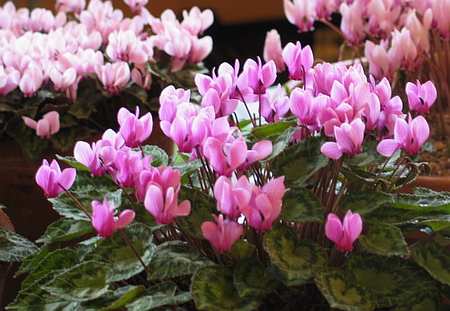
Not just a plant for this month but for most months from September till April. Most plants are cultivated for their flowers and C. graecum does have nice flowers, as do all the other cyclamen.
Why would you choose to grow a species which demands protection for winter wet and severe frosts when you can grow Cyclamen hederifloium in your garden very easily?
One reason would naturally be ‘because we are rock gardeners and folk don’t expect rock gardeners to be sensible’
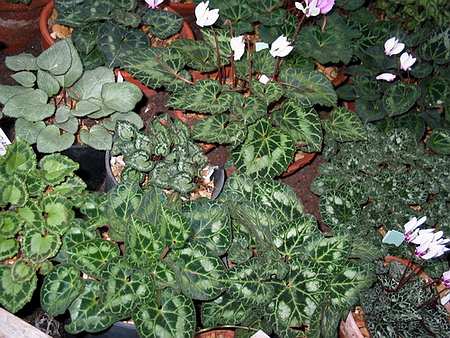
C. graecum showing leaf variety
The real reason that it is worth taking the trouble to please Cyclamen graecum is because it has such wonderful leaves. Better than all other cyclamen and most other plants except Begonia rex. ‘Other cyclamen have nice leaves’, I can imagine you saying to yourselves but graecum beats them all for beauty and variety. No other cyclamen has leaves of such rich texture
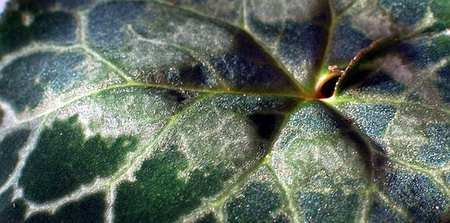
Texture
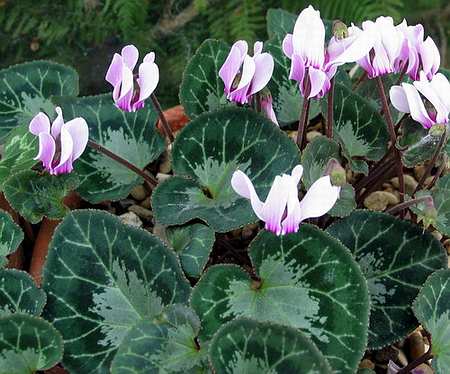
My first C. graecum
My first plant was almost disappointingly dull when I first saw it in leaf. I bought it at the Wirral AGS show before it came into leaf. Don’t do that! Now I like it because it less flamboyant than the others. I waited years to see its flowers too.
LEAVES
C. graecum leaves are special.
Firstly they are marvellously textured.
They are velvety and almost iridescent.
They come in lots of different patterns and shades.
Some open red and many have mature leaves which are red on the reverse.
Some have great big leaves while others have small leaves.
The basic colour is dark green but black, bottle green, grey green and light green all occur, sometimes all on the same leaf.
The leaves are patterned with blotches, speckles and bands of black, green, cream, grey and silver
Cyclamen graecum leaves
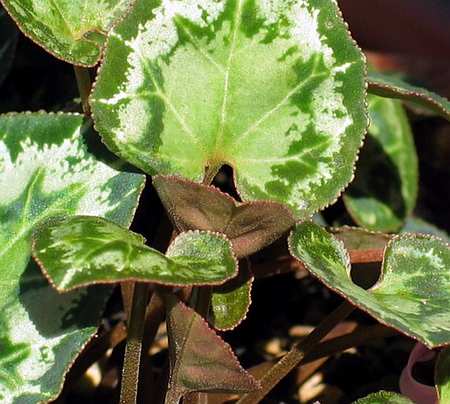
Lots of silver and very red new leaves
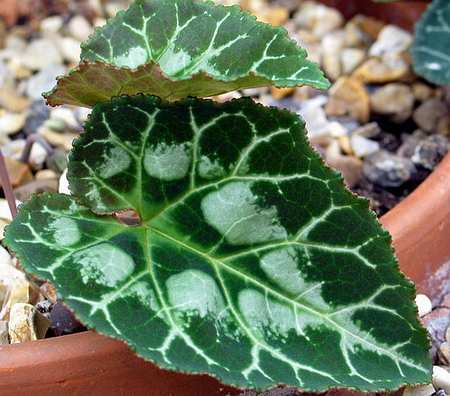
Well marked large mid green leaf
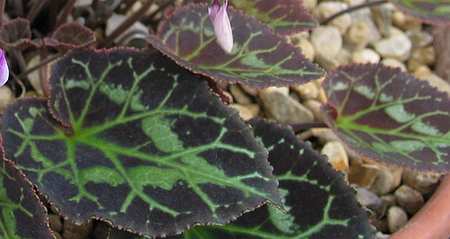
Red tinged leaf
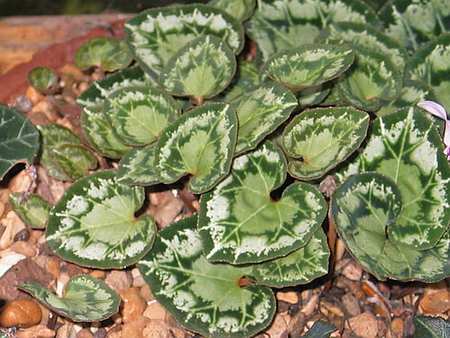
Glaucous leaves on my original plant
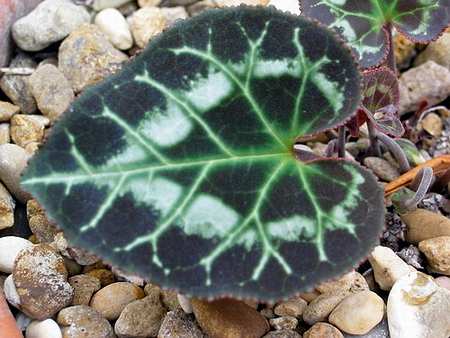
Well patterned leaf
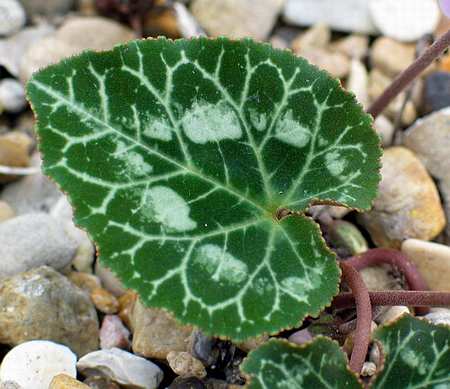
Leaf with nice filligree pattern and blotches
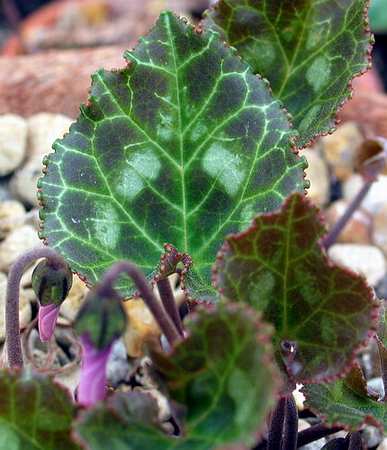
Leaf opens redder
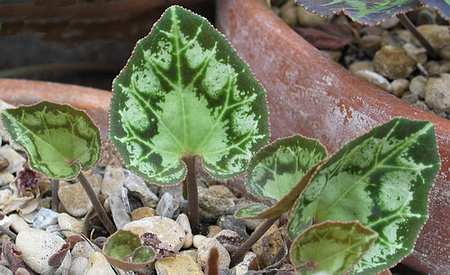
Leaf with pale markings

Leaf with olive green / silver mrkings

Leaf more glaucus in colour
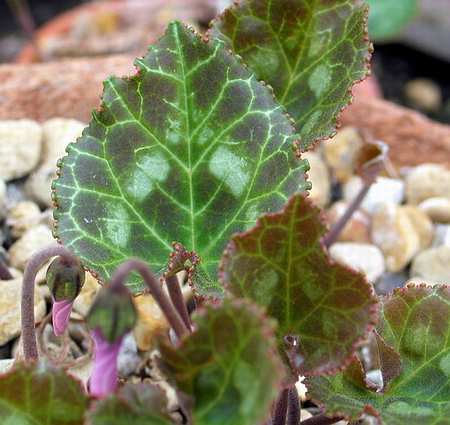
The new leaves with lots of red
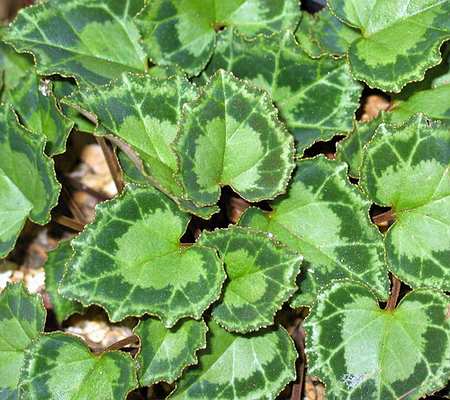
Geranium leaf shaped leaves
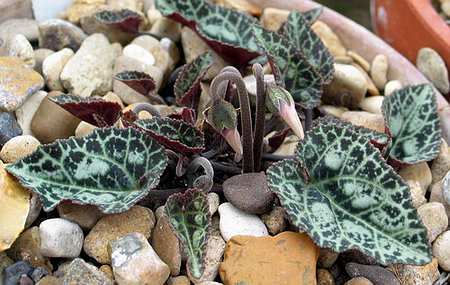
Leaf with fine filigree marking
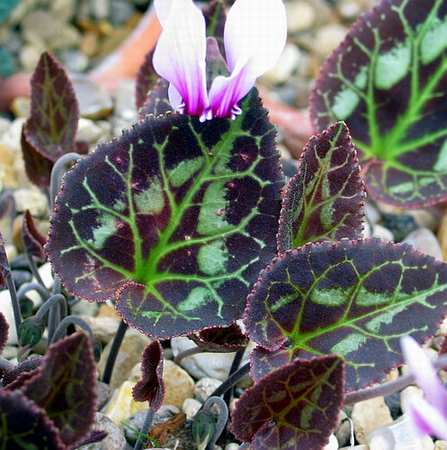
Leaf of ‘Alice Spencely’ seedling
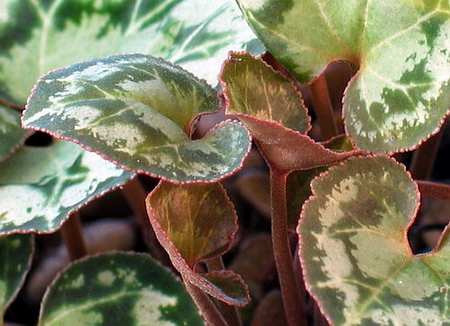
Very red new leaves

The sun brings out the red colouring in the leaf surface
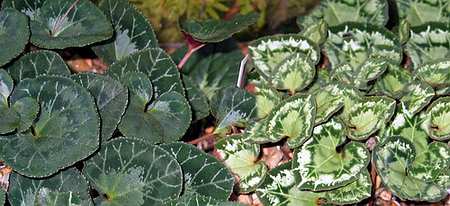
Leaves on the palest green plant
FLOWERS
Flower colour varies from palest pink, through the warmer shades to deepest magenta and to pure white. [the white graecums are available from specialist nurseries at reasonable cost and are said to come true from seed].
Flower size varies as does the size of the auricles at the mouth of the flowers.
The flowers often have dark blotches at the base of the petals and the colour runs up the veins in the flowers.

Cyclamen graecum plant in flower
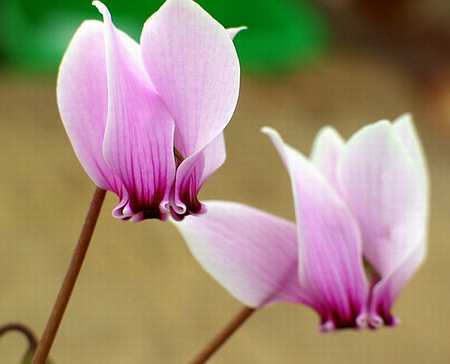
Cyclamen graecum -- short stubby flower, big auricles
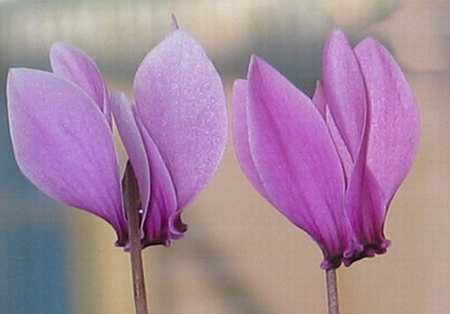
Cyclamen graecum -- narrow flower
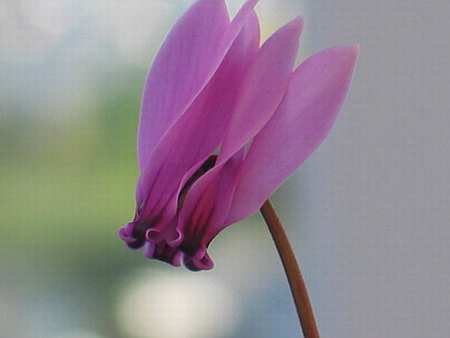
Cyclamen graecum -- flower with twisted petals
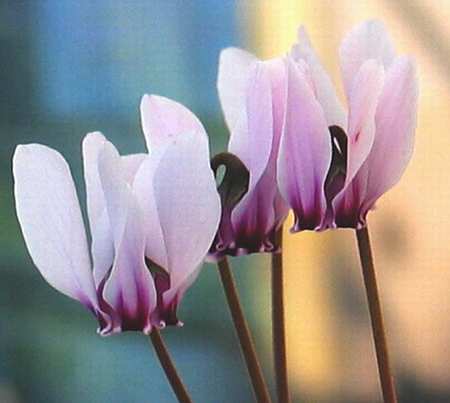
Cyclamen graecum candidum flowers
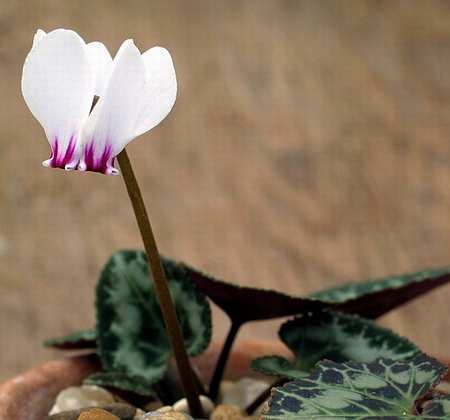
Cyclamen graecum pale flower
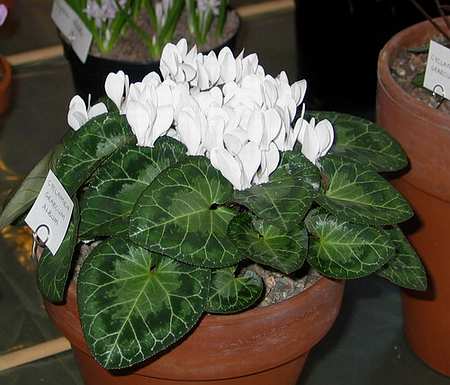
Cyclamen graecum album
Most of my C. graecum have been grown from Cyclamen Society seed.
10 years ago I sowed seed from plants originating in Crete and from a mixture of cultivated forms. I am delighted with the resulting plants. I have a range of leaf forms and flower colours. Some have very large flowers, some very dark flowers some have flowers with twisted petals. A well flowered plant is beautiful to behold.
TAXONOMY & HABITAT
Modern taxonomy recognises 3 subspecies [but I find them difficult to separate when looking at plants grown in cultivation from seed collected in cultivation].
These are :-
Cyclamen graecum ssp. graecum,
ssp anatolicum
and ssp. candidum.
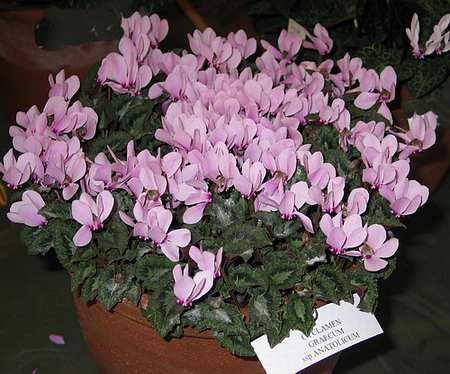
Cyclamen graecum anatolicum
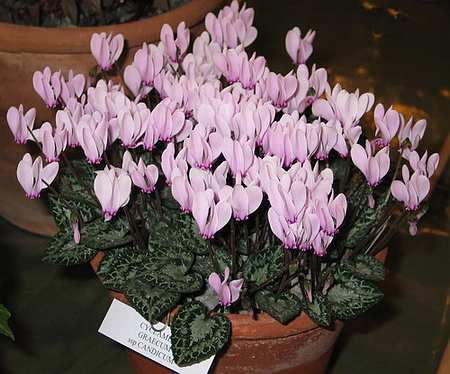
Cyclamen graecum candidum
I dare say when you are in the right place in Greece or Turkey where you know a certain subspecies grows then you know which subspecies you have found. In cultivation Bob and Ranwieg Wallis of Hidden Treasures keep them separate and my candidum come from them. They are arguably the best growers of C. graecum in the country.
In the wild they grow in cracks in forbiddingly hard rock and in pine litter and everything in between.
LEGEND
In 1982, 83, 88 and 89 The Forrest Medal was won at the autumn Discussion Weekend shows by a truly stunning plant of Cyclamen graecum shown by Mrs Alice Spensley. Even at the time she won her 3rd Forrest she was still entering in Section II. She exhibited a wonderful plant with fabulously marked leaves; a mixture of pale and dark green suffused with red with wonderfully intricate patterns. The flowers were a mid rose colour and were always present in great number. I coveted her plant. Alice was a generous grower. She gave me a seedling plant from her Forrest plant and I bought another in an auction at one of the Discussion Weekends. It has taken me a long time to grow them into big plants. I still cannot replicate the number of flowers Mrs Spensley produced but then again I don’t have a front porch. This is where she grew her plant and for her it just ‘did its thing‘. The plant stock originated in Cyprus decades ago, before CITES regulations were introduced.
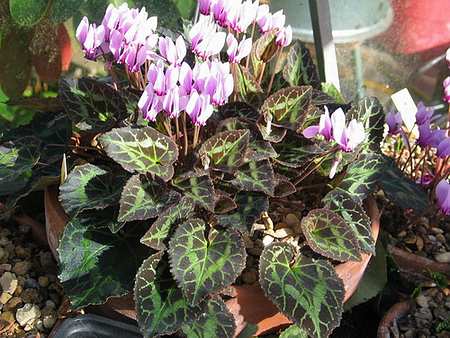
Cyclamen graecum. My seedling from Alice Spensley’s plant
CULTIVATION
In Central Scotland Cylamen graecum requires the protection of glass and I keep mine just frost free. Often, in mid winter, there is ice inside the glass in the early morning. Most are grown in clay pots, plunged in sand about half way up the pot. The tuber is set quite high in the soil and covered with gravel. I believe the tubers of the plants C. graecum in the National Collection at Ashwood Nurseries are set in gravel above the soil in the pot.
My plants are re-potted in August most years and watered after re-potting. The leaves start to appear soon afterwards. I believe it is the care they receive between April and August which is important in determining whether they will flower well…or not. As instructed by Glassford, I never let the pots become totally dry, in spite of what others have told me. The thick roots on the bottom of the tubers are permanent and they are important. The sand in the plunge under the pots is always kept damp, so the roots are never dry. The pots get lots of sun on top during summer and I believe this ‘ripens’ and develops flowering buds. Suffice to note that since I have been following this regime I get more flowers year on year.
I have plant of strain called ‘Glyfada’. this has completely smooth leaves which are pewter coloured, like pewter coums and hederifloiums. This strain originated from a plant collected quite recently near Athens Airport. You would imagine, would you not, that new plants would be found in he back of beyond rather than near the modern airport of one of the oldest cities in Europe?
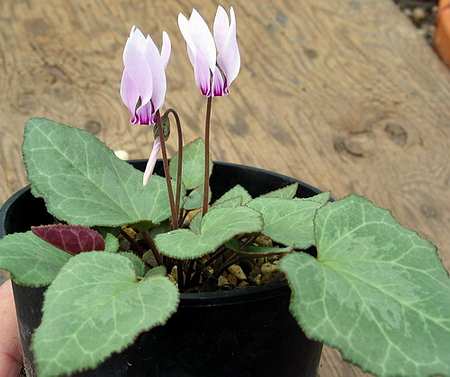
C. graecum ‘Glyfada’
I can recommend collecting [not from the wild but from nurseries and SRGC /AGS sales tables] and growing Cyclamen graecum forms as an absorbing, interesting diversion from the chores of winter. When other folks roses are dying back, their dahlias are black and there are no bedding plants in flower the graecums are beautiful, whether in flower or not.
INTERESTING?
Cyclamen graecum is known as Greek Sowbread. Why? Did they use pigs to dig up tubers and make bread from the tubers? My understanding is that cyclamine in the tubers is a drastic purgative, so that would rule it out for routine morning toast. Perhaps cyclamine is destroyed when heated during baking.
Greek, Roamn and Arabian physicians used cyclamen juice from fresh ‘roots’ to treat phlegm, enlarged spleens, liver diseases like jaundice and hepatitis as well a for violent headaches with flashing before the eyes and for burning pains in muscles and on the skin. It is written that those who used the remedies might have an aversion to fatty foods and to desire inedible things like chalk, earth and worms! They could be prone to depression and be full of remorse.
If someone ground up my Cyclamen graecum I am sure that I would be depressed and remorseful before uttering unmentionable oaths and curses.
I will not eat my Cyclamen graecum I will just admire them.
Cyclamen graecum different leaf forms together

Dark and pale leaves
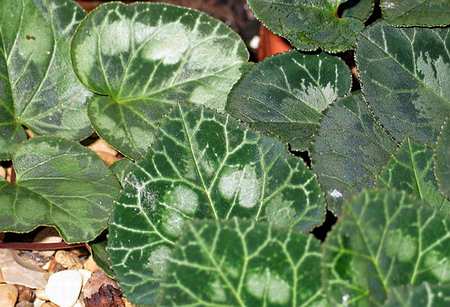
3 different leaves
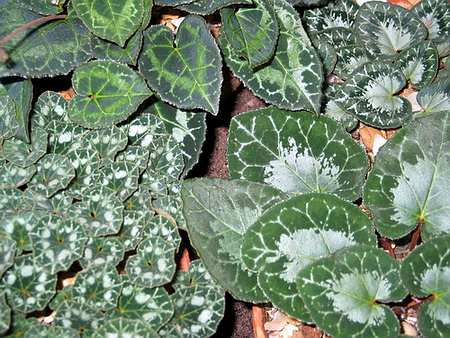
4 different leaves
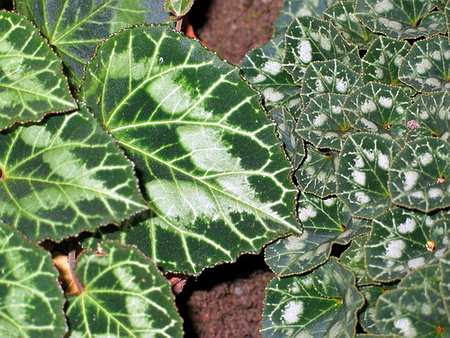
Big leaves and small leaves
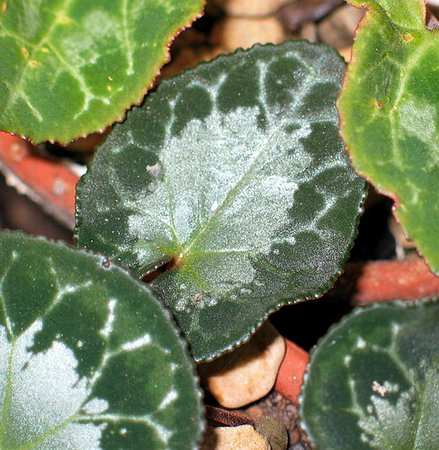
Shiny centred leaves
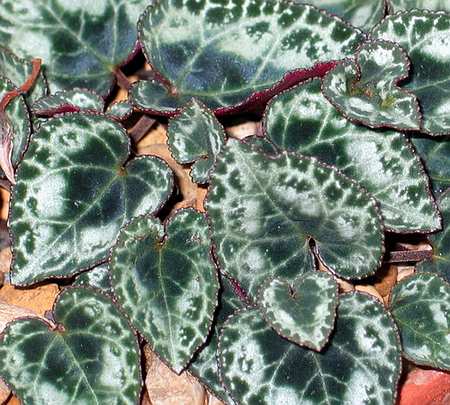
Leaves with red edges
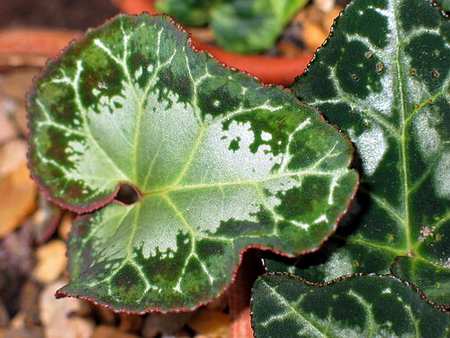
Pale centre & dark centre
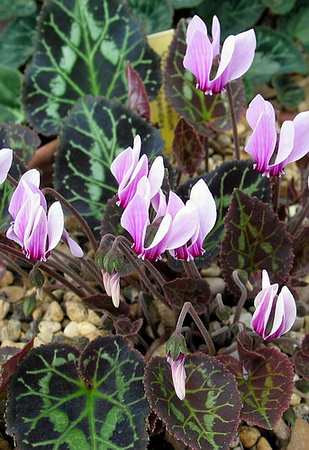
My favourite leaves. Green, silver and red
Enjoy collecting, raising and growing Cyclamen graecum. The seemingly infinite variety of flower colours, leaf patterns as well as the sizes of both will ensure that you will always have something else to look out for. I was mesmerised by the plants at Ashwood. If you drive South on the M6, take time to call in for a look at this wonderful nursery /garden centre near Woverhampton…..……. and the cakes!!!!!!
^ back to the top ^
|

